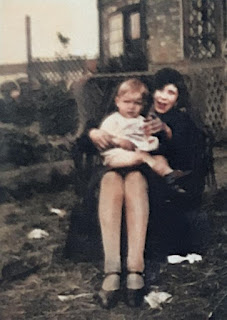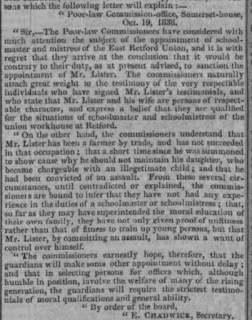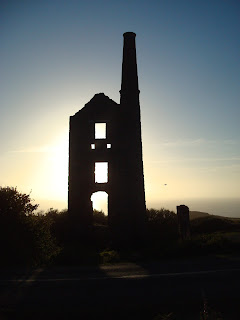Sadly my auntie Joan, my Mum's elder sister passed away at the beginning of this week. She was 95, a grand old age, she was always fit and full of lots of spirit, the last time I spoke to her on the phone she complained about all the dithering old people around her whilst she was probably one of the oldest.
During the war Joan worked in the intelligence department as a wireless operator, copying down messages etc. because she had signed the official secrets act she was not allowed to tell her family what she did, even after the war.
A few years ago, seventy years later, she was allowed to talk about what she did during the war.
Here follows is her story in her own words, her feisty character shines out, I'm so glad that she shared these memories with me.
"My Memories of W.A.A.F WWII November 1941 – 1945
By Joan Staveley
Ex 2052480 J Orwin WAAF
The war was on. I was working in an office at the time. What help was I here; it
wasn’t helping the war effort. I decided then and there even though I was
officially still too young (by 6 months) I was going to join up.
First things first, need to talk this through with Dad and my brother.
Dad – Herbert Orwin already in the RAF spending a lot of time in India
Brother - Cyril Orwin – Joined as a boy apprentice in the RAF, eventually trained to become a fighter pilot, shot down and became a prisoner of war. Continued to serve after the war and rose to the rank of Group Captain.
Dad was very understanding and gave his blessing. He said it was better to join up
as you could then choose what you wanted to do rather than wait to be called up
and end up in munitions or the army or something else that you didn’t really
want to do.
So the next day I went to the recruitment office. It was 12 noon and only a WAAF
CPL on duty (the officer had gone to lunch)
She asked for my birth certificate, I crossed my fingers and lied! (Naughty) I told
her that all my papers including my birth certificate had gone when a land mine
had dropped near our house (the land mine part was true!) I proceeded to tell her
that my date of birth was 7th April 1924, making me seventeen and a half; just old
enough to enlist (my real birth date was the 7th September 1924). It was November 1941.
Off I went, AC Plonk Joan Orwin 2052480. I caught the train to Bridge North
arriving around 22.00 hrs. Awaiting us new recruits was a lorry (covered) to take
us to the camp (ooh! Mum what have I done?)
On the journey to camp I met Dorene North from Bradford (from this time on
through to 1945 we were to become known as the ‘’Terrible Twins’’)
We did our Square Bashing and had a jab or two. I remember Vera Henn who had
been a model before the war, hitching her skirt up to have the jab at the top of
her leg so that she wouldn’t have an unsightly scar on her arm. So up went our
skirts.
After our square bashing we were posted to Aberdeen to do our training which
took place in the main post office in Crown Street. We were attached to Dyce
Aerodrome but only actually visited it once as we lived in civilian billets.
I stayed at Mrs Wisharts in Princess terrace with her son, daughter, (who was a
manageress of a large hotel) 2 trainee male doctors, a female school teacher, Vera
Henn, Phil Wright, Betty Wrights and myself who were WAAFS.
My friend Dorene North was billeted across the road with 10 other WAAFS, but we
were looked after much better than they were.
During our time there we would often after training, get changed into our civvies
and go off to the dances. We had the best of both worlds.
I remember about a week after having our jabs Vera and I went to the pictures
with two sailors we’d met. During the film I broke out with vaccine fever and the
two sailors had to give me a chair lift back to our digs as I couldn’t walk. I went to
bed. Vera said she would get Donald one of the trainee doctors to have a look at
me. I pretended to be asleep. There was no way I was going to let him look at the
lump near my groin where I had had the jab He came in and said to Vera ‘’let her
sleep’’ (relief). In the morning I was a lot better.
Our training took 6 months. During this time we were taught the Morse code by a
civilian gentleman call Mr Strachan. After training was completed we were given
our SPARKS (Government Code and Cypher School)
After Aberdeen we went home on a weeks leave and then we were sent to
Blackpool for two weeks for more square bashing.
We were then moved to Compton Bassett for a week. We arrived there at night. It
was freezing and we all had our great coats on. As we climbed out of the Lorries
these Erks! All chanted ‘’you’ll be sorry’’ they thought we were new recruits. You
should have seen their faces when we all walked into the NAAF the next morning
all proudly showing off our SPARKS. They were still training , I think they had only sent us to Compton Bassett to kill time, because a week after we were posted to Y Station CHICKSANDS PRIORY in Bedfordshire.
We arrived about lunchtime and by teatime we were being sent home on another
weeks leave. (funny??) We didn’t know why at the time, but now know it was to
give them time to vet our background (MI5 and all that). When we came back off of
leave, many who had been with us when we first got to Chicksands were no more!
So here we were to stay until November 1945.
We signed the official secrets act and were told to say nothing to anyone. Even my Dad, brother and husband, all died never knowing what I actually did.
My nickname in the camp was Mickey, I was given the name because there were
three Joan’s in our hut which made things confusing. One remained Joan, one
became known as Briggsy and I was given the name Mickey due to the fact that my Dad used to call me Mickey Dripping when I was young. Problem solved.
We first started working in the Priory itself (later to be called the Officers Mess)
and when we went on duty the Army were guards on the door. All the rooms had
wireless sets arranged around each of the rooms and we would just plod on taking
messages hour after hour (boring we thought, but we got used to it, it became a
way of life). We did no transmitting at all after our training only intercepting.
Then the wireless blocks were built and that’s where we then spent our time,
night shift, day shift or evening shift. When you entered the blocks you had to go
in through a maze and you came out through a different maze with RAF personnel
on duty guarding you. We had some laughs and some tears but I wish I could go
back to it again.
Doreen and I were in Hut 121 (top camp the men were in the bottom camp) there
were lots of nice people, Mizpah North, Joyce Fuller, Doris Spershott, Mary
Froggart and Joan Briggs to name a few.
I remember Joan Briggs, Big girl, big bust who used to work as a telephone
operator in Manchester. We were talking about the cost of phone calls, she said a
call cost 3d, I told her we only paid 1d. Well she was so adamant ‘’ everyone pays
3d for a call’’ and she wouldn’t believe me. Next time we went on leave Dorene
came with me to Hull. One day we were passing a phone box and I said ‘’here
Dorene here’s 1d, ring Mum up and tell her we will be home for tea in a quarter of
an hour’’ She did so and the cost? 1d, so I said to her ‘’when you get back to
camp tell Briggsy how much that call cost you’’ You see Hull has its own
telephone exchange and still has today.
We had many adventures during our time together. One day Dorene and I were
hitching a lift into Bedford when David Niven (film star) drove by in his army
officer’s uniform on a motorbike, he gave us a wave, he was gorgeous. Then a car
stopped to give us a lift (you wouldn’t dare hitch hike these days) it was two men,
a young fellow called John Banks and an older man. They said they were going
greyhound racing and would we like to go with them. Well we had no special plans
so off we went to the other side of Bedford to a field were the races were held.
There was a lot of people there and we had a few laughs, we had a meal there
then the boys deposited us back at midnight at the Sandy Lane entrance to the
camp in time for duty.
In our hut we all used to take turns to light the stove which was in the centre of
the room and the only means of heat. Imagine in the winter, snow covered coke
which is bad enough to light when dry never mind when it’s wet. We used to have
to rake the snow off it and try to light it. Not an easy thing to do which is why the
NAAFS mound of coal used to dwindle at an alarming rate as we all used to sneak
over there and pinch it so we could start the stoves.
Dorene’s grand parents lived in Hammersmith so most of our weekend leaves were
spent there. Funny every time I went they had a raid free night and they would
say ‘’ good Mickey’s here so we’ll all have a good nights sleep’’. That is until one
night when we were at Hammersmith Palais (Ted Heath, Joe Loss Bands) and boy
was there a raid. Dorene and I being small, cottoned onto two tall Australian’s
hoping they would protect us when we left the Palais. We were climbing over
rubble and hose pipes, talk about pandemonium. After that, going to
Hammersmith didn’t mean a night of no raids anymore.
One of the last Buzz Bombs fell at Chicksands Priory but, luckily it fell on the
bank of the river which ran through the camp. The bottom camp (men’s camp)
took the blast. Luckily the huts that caught the blast were empty except for one
chap who had a night off and he only got a gash on his cheek – Lucky!
We also had a horror of a man Warrant Officer Paige, every camp had one (funny
that)
We often went to the dances were Glenn Miller and his band were playing. They
were stationed near Bedford. I actually saw Glenn Miller the night before he went
missing. We were going into The Bridge Hotel and him and a couple (civilian man and
woman) came down the stairs and got into a taxi. Guess we were one of the last
few to see him. He had gone the next day. A big loss to the music world.
I remember one night, we left the Corn Exchange were we’d been to a dance and
were dashing for the train. There was one in the station so we jumped onto it,
whoops. The train didn’t stop at our station Shefford Village were Chicksands was.
We were on the wrong train and the first stop was Luton. There was no train back
so we went to the police station and they rang the camp to inform them we
wouldn’t be back and put us up for the night. We got the first train back the next
morning and we were put on a charge.
Another memory of mine is of the cold weather and going on duty at 8 a.m.
It was so cold, too cold to walk to the ablutions and wash in cold water. So we
used to use the water from our hot water bottles (still luke warm), we’d pour the
water onto our flannels, it was so much nicer than a freezing cold block and
freezing cold water.
Going back to our training time, there was a girl that sang with a big band at the
Palais, Elsie she was called I often had a chat with her. Well blow me down if a
year and a half later didn’t she arrive at the camp. She’d joined the WAAF; I never
thought I would see her again. She sang with the camp band then along with a
male singer Alf Adcock.
Whilst we were in Aberdeen Vera Henn was dating a naval officer who lived there
and his sister Rose was a nurse at the Cottage Hospital. Rose asked us if we would
visit some of the Canadian soldiers there who were badly burnt. So we used to go
and visit them and write letters home for them as they had no one else to visit
them (tragic). Quite a few of them died and the other badly burnt lads must have
being in agony, you could smell the burning flesh. They were only 18 or 19 the
same age as us.
We had a fire at Chicksands in one of the huts. Rosemary Portal (sergeant) was the
one in charge of it and she had a small room at the end of it. When they had all
gone on duty the hut went up in flames (SQDN 1)
The next day a car with its flag flying arrives at the camp with Lord and Lady
Portal the mother and father of Rosemary. As far as I can remember Rosemary
who had an electric fire in her room (forbidden) and had gone on duty and left it
on. It must have being too near the bed and set alight. I wonder what happened to
her?? More to the point I wonder what would have happened if it had being one of
us (not being the daughter of a Lord in the RAF!) who had caused the blaze.
Yes we had some good times and it was hard to imagine ourselves back in Civvie
Street.
None of us had our teenage years like the kid’s of today had but we met some
really great people and looking back I wouldn’t have missed any of it.
Great friends Dorene North, Lorraine Craddock, dear old Mickey Maules (CPL) my
name sake. It gave us a little bond ‘’the two Mickeys’’. I remember Sgt Bustard,
Sgt Jones, CPL Smith, Sgt Sandy Brown, Gwen in our hut, Mary Durdy, Freda
Dewhurst, Nobby Clark and Alma Savage.
I’m left with many happy memories which money can’t buy
QRX (closing down code in Morse)"

































